
Images: (left) Bryan Versteeg, spacehabs.com; (center) Raymond Cassel; (right) NASA
- Roadmap Table of Contents
- Part 1: General Milestones (this page)
- Part 2: Utilization and Development of Cislunar Space
- Part 3: To the Moon
- Part 4: To Mars
- Part 5: Asteroid Mining and Orbital Space Settlements
- Part 6: Additional Expansion and Greater Sustainability of Human Civilization
GENERAL BARRIERS TO SPACE SETTLEMENT
At every stage, certain barriers will be encountered. A barrier is a substantial obstacle to achieving a milestone, and it must be overcome before the milestone is achieved.
Technical. There are technical barriers to providing safe, reliable, efficient and inexpensive transport to, from and in space and between locations in space, as well as the technical difficulties in creating space infrastructure, human habitats and industrial sites. A major current technical barrier is still the creation of reliable reusable rocket boosters, even though parts of that barrier are now being overcome. Another significant barrier is the lack of mitigation of debris in Earth orbit.
Biological. The main biological issues are human responses to (1) microgravity in non-rotating space habitats, (2) long-term exposure to radiation in space, and (3) the lower gravity levels and other conditions on other planetary bodies.
Cultural. For many, the pace of space development is frustratingly slow, especially when compared to the fast pace of computer revolutions. Space development would be furthered by greater education of the public and by stimulating and sustaining public interest over long periods of time. It is amazing the extent to which space is now integrated into every aspect of our civilization without people even being much aware of it.
Psychological. Psychological issues include:
(1) Claustrophobic response to an enclosed and confined space habitat, knowledge that you cannot walk outside the habitat at any time, and the awareness of the risk of loss of air pressure.
(2) Isolation from others due to communication lag.
(3) Lack of exposure to a natural environment (“nature deprivation syndrome”).
(4) Challenges inherent in human interactions within an initially limited population.
Social. For alleged “safety” reasons, governments are tempted to limit the ability of private individuals to organize and undertake space ventures or to voluntarily accept the risks of travel into space. If there had been such societal restraints two hundred years ago, the frontier of the American West would not have been settled then. Space development requires the freedom to voluntarily take risks and, consequently, societal aversion to risk-taking is a barrier to be resisted and countered.
Economic. Space development requires long lead times, and therefore needs long-term funding. Economic issues, both actual and perceived, are often major barriers, both to governmental and private efforts.
(1) The very high cost of access to Earth orbit and space has to a large extent prevented the transport of passengers and cargo to, from and through space as has historically been done through the air for many decades.
(2) Governments, unfortunately, have inherent pressure to think in the short-term and perhaps just to the next election. Even if they authorize long-term programs, they seldom simultaneously provide long-term funding, even if it would result in significant savings over the life of the program.
(3) Private sector investors seeking immediate gains rather than long-term profits. In order to encourage private investment in space activities, governments need to provide an encouraging environment, for example, by reducing or eliminating unneeded regulations, by legislating limits to liability in the case of space-related accidents, by allowing space travelers to take voluntary risks, or by providing rewards for or tax relief from space ventures.
MILESTONE 1. Dramatically Lower Launch Costs to Orbit
 Falcon Heavy booster landings. Image: SpaceX
Falcon Heavy booster landings. Image: SpaceX
DESCRIPTION
The emergence of partially and fully reusable rocket boosters and other efficient means of reaching orbit will result in more efficient and reliable launch vehicles or methods with faster turnaround times and higher launch rates. These improvements will significantly lower the cost of access to space, allowing a much larger launch market which then could further assist in launch cost reduction due to higher demand. These improvements will also enable multiple new uses of space which are currently too expensive for practical use. Such uses could include space solar power, space tourism to orbit, and additional types of commercial uses of orbital space.
Progress on this milestone will be demonstrated as new uses, such as those given above, become affordable. Significant progress toward this milestone is likely to be made within a few years.
COMPONENTS (methods of fully reaching this Milestone)
Private Launch Companies. The emergence of private launch companies who provide launch services for both government and private customers is revolutionizing the launch industry. The focus on reusable rockets by several companies will eventually reduce launch costs to a fraction of current rates and finally allow high mass space operations.
Government programs. Technology development and other programs by U.S. and other governments may assist in reducing launch costs.
Flight Test Demonstrations. NASA, other government-funded agencies and private companies continue their roles in developing space transportation technology specific to achieving operational cost reduction through flight test demonstrations of technology. These activities create “on the shelf” technology for industrial/commercial uses.
Government Contracting Practices. Government contracting practices and policies that encourage the design, construction and use of newer technologies are needed. These policies should emulate more commercially reasonable practices, which will likely dramatically lower the cost of government-funded efforts. Such practices include continuing to move from direct responsibility for managing the development of launchers and other hardware to just purchasing hardware and launch services for crew and cargo from commercial sources. With a government as a stable customer, a market is likely to be created which will encourage competition among many enterprises, existing and new, which will inevitably further reduce the unit cost of each space flight.
Progress in Launch Technology. Launch rates alone cannot be counted on to reduce launch costs (for example, if labor costs for construction and launch are too high). Improvements will occur in methods used for the design and physical construction of boosters, testing and preparing them for launch, and operating them before and during launch, which will speed and automate operations and thereby reduce cost. One significant example is the use of reusable vehicles. Eventually non-rocket launch methods, such as magnetic acceleration with linear motors for certain cargo, might be developed. Other examples include standardized payload containers and test procedures to minimize loading operations costs. Additionally, launch costs can be reduced by large vehicles that fly routinely such that no one customer is paying for the entire launch, or on smaller vehicles such that a dedicated launch is affordable to a wide range of customers.
Space Tourism. Space tourism may develop into an industry requiring numerous launches that will lower the cost of each launch to commercially sustainable levels. Hundreds, perhaps thousands, have already made deposits on private suborbital flights. These journeys will later extend into Earth orbit and then into orbits around the Moon and back.
Commercial Facilities in Orbit. With the development of reliable and affordable space transportation, private enterprises could develop commercially profitable orbital facilities, e.g., hotels and factories. These facilities will be large enough to allow travelers to enjoy the feel and unique opportunities of zero gravity for extended periods, but small enough to be able to move to avoid known space debris. It is likely that transportation and facilities will evolve together, in that the availability of one will serve as a commercially justifiable rationale for the other.
Space Solar Power. A different path to enabling a market to support high launch rates and lower costs to orbit might be forged by the world’s need for power. In this case, human travel to destinations in and beyond Earth orbit would be an incidental benefit rather than a primary goal. If and when it becomes apparent that space solar power is a practical energy source, or that all available conventional sources of power (e.g., coal, natural gas, wind, hydroelectric, geothermal, nuclear, and ground-based solar) will either be inadequate to meet the needs of society, will be too expensive for some markets or have unacceptable side-effects, people will look more closely at space solar power, or SSP. This is sometimes referred to as space-based solar power, or SBSP, since it involves satellites in space harvesting and transmitting the Sun’s energy down to Earth. The SSP systems that emerge could be built by private enterprises on their own or by governments, or by some sort of partnership. Either way, those systems require and therefore will result in the high frequency of launches that drives costs down.
Other Commercial Space Applications. Other potential commercial space applications may lead to increased launch rates and decreased costs. Examples are robust communication satellite architectures, low Earth orbit data switching/storage networks, orbital servicing infrastructures, or robust global surveillance constellations.
Governmental Policies. Whether or not governments believe in, or are willing to wait for, private enterprise to lead the way, they, as a national policy choice, may commit to the building of large space outposts in Earth orbit, on the Moon or elsewhere, which will require a number of launches over a sustained period large enough to reduce the per-launch cost to financially practicable levels. Such governmental initiatives may be created by a desire for prestige or to not be left behind by the space initiatives of other countries, by a concern for protection from asteroids and comets, by the need for a space-based solar power system to transmit solar power to Earth, or by government uses of space for security, environmental surveillance, improved communications, or many other uses, as well as by the traditional philosophical, political and economic policy rationales long articulated by NSS and others in the space community. Such initiatives will increase launch rates and reduce unit costs. To be effective, the policies must use launch costs as one of the primary criteria for selecting a launcher. Further, government certification requirements should not unfairly penalize or impede the use of reusable vehicles.
BARRIERS
- Continued government reliance on and support for expendable launch systems and in-space vehicles.
- Bias toward pro-expendable government policies by government employees, private contractors and venture capitalists resulting in a reluctance to work openly on other technologies.
COMPLETION
This milestone will be considered achieved when launch prices to Low Earth Orbit will no longer be a major barrier to space operations. (This means dropping by a factor of ten or more below the average 2017 global price of about $5000 per kilogram).
MILESTONE 2. Continuous Human Occupancy in Low Earth Orbit
Construction of continuously occupied pressurized structures in Low Earth Orbit (LEO).
 Proposed Axiom Space commercial space station follow-on to the International Space Station. Image: Axiom Space
Proposed Axiom Space commercial space station follow-on to the International Space Station. Image: Axiom Space
DESCRIPTION
From the U.S. Skylab, to the Soviet Mir, to the International Space Station (ISS), and China’s Tiangong, crewed structures have been placed in orbit and one has been continuously occupied for over a decade. These space stations are essentially tools, rather than ends in themselves – laboratories in which we learn how to construct large structures in space, live and work in space, gather biological data, avoid or survive space debris, and explore scientific principles and technologies that can be developed only in space.
The International Space Station will be followed in orbit by other human-occupied facilities, such as hotels, laboratories, factories and depots, with many being commercially owned and operated. These would support space tourism and recreation, scientific research, low-gravity manufacturing, space solar power infrastructure, refueling and repair operations, and the like. The lessons learned will be applied to later space settlements.
COMPONENTS (needed to create a habitat in space)
No permanent space settlement can be constructed without first accumulating: (i) the technical knowledge, industrial tools, unique materials and techniques necessary to create such a novel habitat, as well as (ii) biological data about the ability of terrestrial life to survive and thrive for long periods of time outside Earth’s atmosphere and gravity.
That knowledge and expertise has been and will be acquired by the launching or construction of large structures in Low Earth Orbit (LEO). LEO is the closest place in which research can occur and techniques can be practiced, and from which escape in an emergency is most feasible.
Over time, newer equipment will be added and critical new experiments will be conducted onboard. A variable gravity centrifuge, large enough for small mammals, is needed to determine the effects of living in lunar or Martian gravity. Also needed are tests with space solar power wireless energy transmitters and receivers, closed or controlled ecological life support systems, and larger, more efficient electrical power systems.
BARRIERS
- High launch cost to LEO
- Insufficient focus on non-pressurized docking, external logistics and robotic cargo handling for LEO operations
- Insufficiently developed economic justification for ongoing LEO activities
- Man-made space debris accumulating in LEO and posing a hazard to life and property so long as effective international mitigation efforts are lacking.
COMPLETION
The attainment of this milestone will be recognized gradually when inhabited orbital infrastructures (1) seem permanent, (2) are supported by sustainable economic activity, and (3) include at least one commercially owned and operated LEO station.
MILESTONE 3. Development of a Space Tourism Industry
Growth and development of a robust space tourist industry, including frequent orbital and suborbital flights and a growing number and sophistication of space hotels.
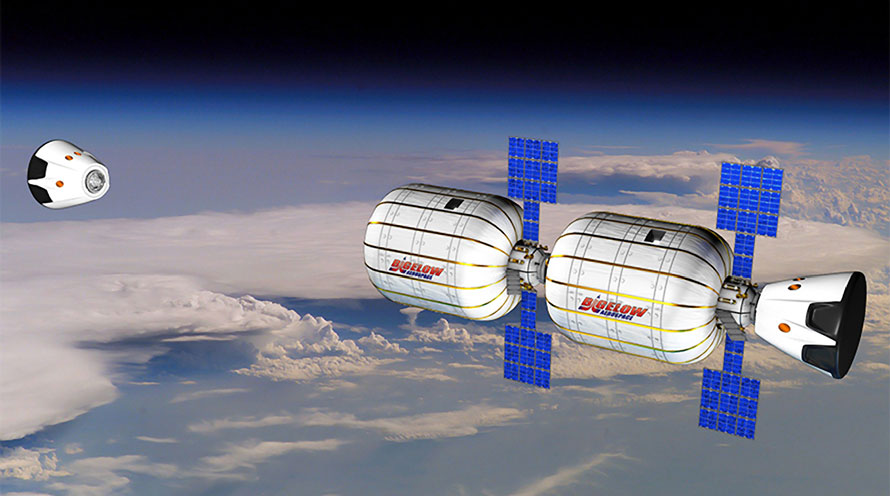 Space hotel. Image: Bigelow Aerospace.
Space hotel. Image: Bigelow Aerospace.
BACKGROUND
As of 2017, the space tourism industry has accomplished nine flights to the ISS, while existing companies are building suborbital tourist vehicles, are envisioning trips to private space stations, and planning a trip around the Moon. Space tourism is price sensitive. Dropping the price significantly expands the market. Thus, tourism can drive launch vehicle and habitat development by generously rewarding reduction in cost. Such increase in the market can lead to economies of scale which further drop the price and stimulate even more market demand in a virtuous cycle. In addition, rocket engines and new large boosters are under development, enabling the orbiting of much larger and more massive single payloads. Such high mass space operations will let industry create larger, safer and more luxurious designs for orbital passenger vehicles and space hotels.
COMPONENTS (type)
Passenger rated launch systems and space hotels.
BARRIERS
- Cost, safety and reliability of launch and passenger carrying vehicles,
- Cost of building and operating space hotels.
- Excessive regulation and premature safety standards.
COMPLETION
This milestone can be considered achieved when (a) at least one facility in space allows regular bookings for tourism or (b) when orbital spaceflights for tourists are scheduled at least several times a year.
MILESTONE 4. Establishment of In-Space Commerce by Private Companies
Establishment of commerce in or between locations in space by one or more companies.
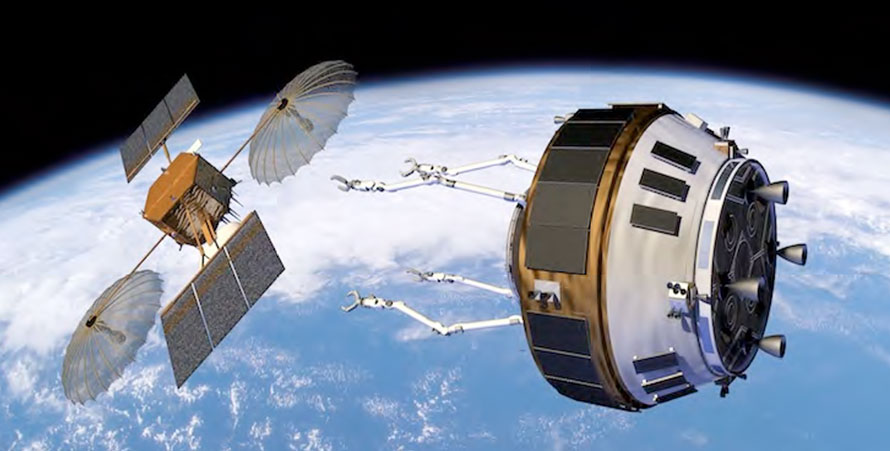 In-orbit satellite repair. Image: NASA
In-orbit satellite repair. Image: NASA
DESCRIPTION
In-space commerce involves operations such as delivery of goods from one location in space to any other location in space or performance of services for any facility in space. Delivery of propellants from LEO to a propellant depot at the Earth-Moon L1 point and production of propellants on the Moon are good examples. Some forms of space commerce (as distinct from in-space commerce) already exist in the form of delivery of goods from Earth to LEO. In-space commerce also includes the manufacturing of products on space stations for later use on Earth or in space.
COMPONENTS
The enterprise(s) would need to be profit making and primarily without subsidies or special governmental protection from failure.
The company(s) would be providing products or services to locations in space which could include tourism. (Note the overlap with space tourism in Milestone 3.)
BARRIERS
Uncertainty about what activities will be profitable and what customers will exist due to rapidly changing space transportation costs and interests of government agencies.
COMPLETION
This milestone can be considered achieved when a company has made a profit on its in-space operations for at least five years.
MILESTONE 5. Crew Habitats for Use Beyond Low Earth Orbit
Safe habitats for crews operating well beyond Low Earth Orbit and outside Earth’s protective magnetosphere.
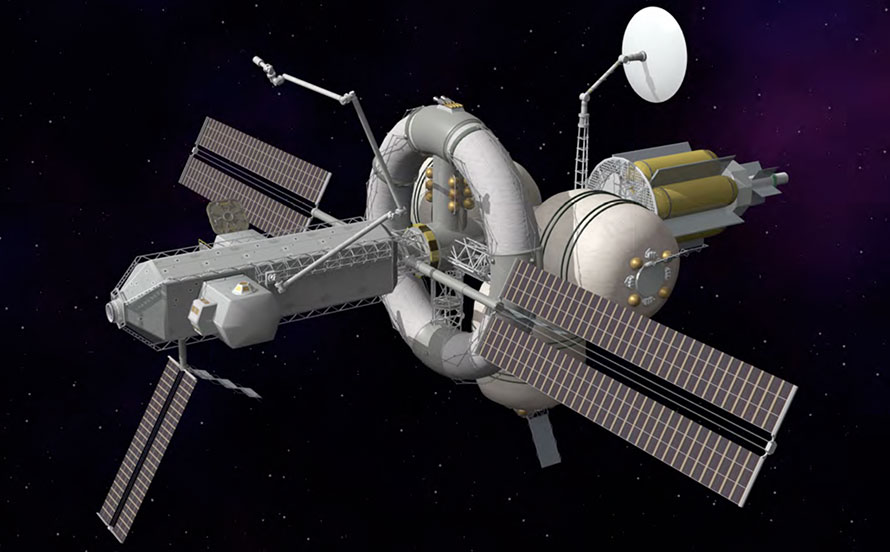 Proposed Nautilus-X Extended Duration Multi-Mission Space Exploration Vehicle. Image: Mark Holderman, NASA
Proposed Nautilus-X Extended Duration Multi-Mission Space Exploration Vehicle. Image: Mark Holderman, NASA
DESCRIPTION
Crew habitats are one of the most critical parts of space infrastructure. Crews operating well beyond Low Earth Orbit and outside the Earth’s protective magnetosphere will be exposed to about twice the constant cosmic radiation and much more solar radiation, including dangerous but intermittent solar mass ejections, compared to locations in LEO. The crews in locations beyond LEO are also farther away from assistance and cannot just land in an emergency. Providing artificial (centrifugal) gravity using rotating or tethered modules may be necessary to maintain better long-term crew health for long durations spent in microgravity locations. (Note that this milestone refers primarily to smaller crew habitats launched from the ground, for trips and at logistics bases, and does not include the much larger residential settlement habitats that would be constructed in space.)
COMPONENTS (required capacities)
Crew habitats beyond Low Earth Orbit must be able to
- Provide redundant life support systems for the crew that will last 50% longer than the designated mission length or long enough for a rescue mission to reach the crew.
- Carry sufficient food and water for the crew and/or recycle water and grow food.
- Protect against constant cosmic radiation (heavy, fast nuclei from outside the solar system).
- Protect against intermittent solar radiation (solar mass ejections and general solar radiation)
- Support possible designs for creating artificial (centrifugal) gravity with rotating habitats.
- Assist in support of the crew’s physical and mental health. For long trips/stays beyond cislunar space, this includes making the habitats sufficiently large.
BARRIERS
- Lack of incentives and resources to construct, maintain and operate habitats outside of LEO that can provide the additional personnel protections needed outside of LEO.
- Lack of consensus over the difficulty of and need for creating artificial (centrifugal) gravity for long-duration flight.
- Lack of consensus over how to best protect crews against space radiation and how much protection is needed.
COMPLETION
This milestone can be considered achieved when a crew module or habitat that supports a crew for six month rotation periods, with effective radiation protection (equivalent to or less than radiation exposure levels to crews in LEO), is in place at GEO or any cislunar orbit or location.
MILESTONE 6. Use of Rotational Artificial Gravity for Habitats and Industry
Building rotating structures that can produce artificial gravity of the desired strength.
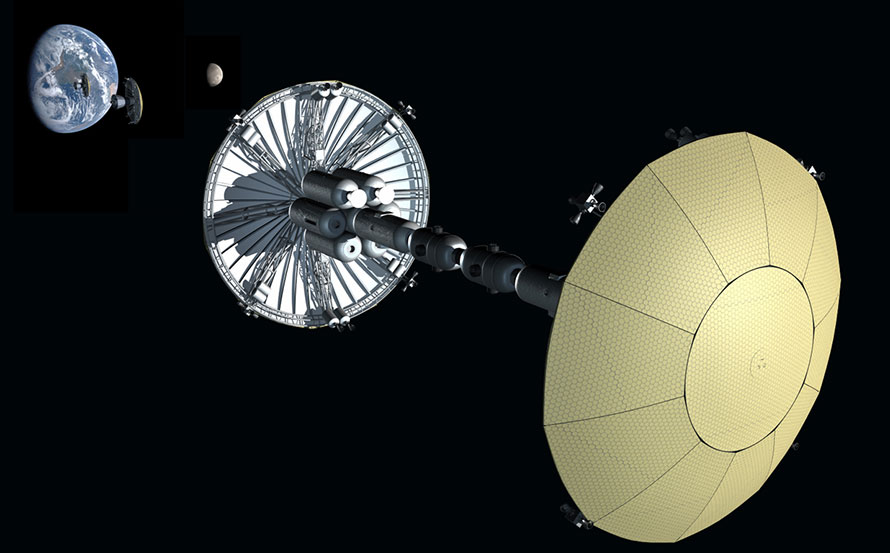 Two temporarily connected rotating habitats (with surrounding habitat storage for shielding) with aerocapture shields for use at Mars. Image: [email protected]
Two temporarily connected rotating habitats (with surrounding habitat storage for shielding) with aerocapture shields for use at Mars. Image: [email protected]
DESCRIPTION
Practical artificial gravity is currently possible only by rotation. The simplest form consists of two habitats rotating around each other on a cable. Larger, more permanent systems such as a torus habitat require larger construction efforts. In such a structure, “down” is away from the center of rotation.
COMPONENTS (types of uses)
There are at least three basic uses for artificial gravity:
- Vehicles or habitats for lengthy human occupancy.
- Transferring cryogenic propellants.
- Mines and smelters for harvesting and using materials from asteroids.
BACKGROUND AND RATIONALE
Producing significant artificial gravity via acceleration can last only a few minutes. However, there seems to be no insurmountable barriers to using rotation to create artificial gravity. The problem is bureaucratic, economic and physical. Rotating environments need to be designed to reduce severe damage from collisions and to reduce fire threats from convection of hot air (which does not occur in a microgravity environment). Such environments should be large enough to be well tolerated by the occupants.
BARRIERS
- Perceived difficulties in creating rotating environments versus microgravity environments
- Risk of collision between spacecraft and parts of rotating environments
- Greater fire threat inside rotating environments
- Larger economic cost for building large rotating environments with lower rotation rates
- Belief by many, especially in government, that there is no requirement for artificial gravity in order to achieve the limited space goals they perceive.
COMPLETION
This milestone can be considered achieved if rotational gravity is used in a human-inhabited module anywhere in space during routine operations.
MILESTONE 7. Legal Protection of Property and Other Rights
Legal protection of property rights enacted to provide prospective off-Earth investors and settlers with the security to take financial risks.
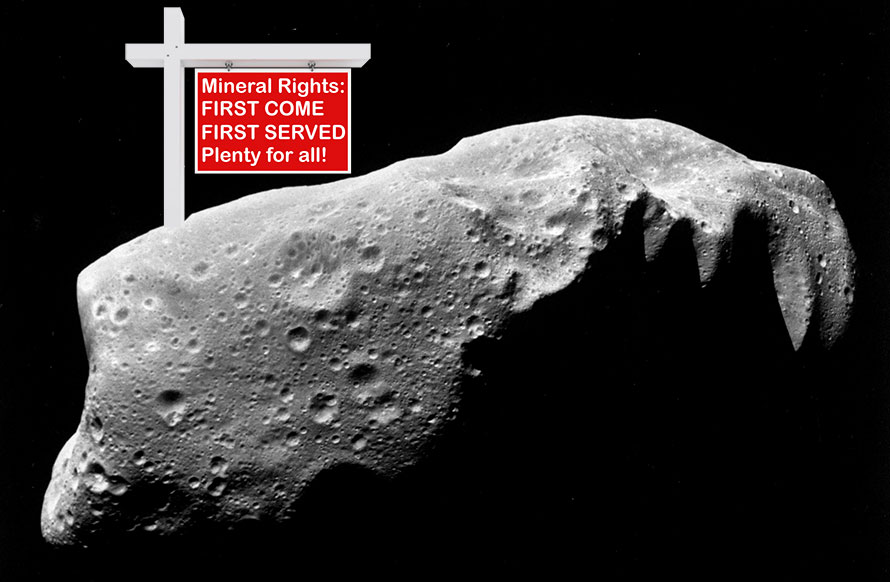
DESCRIPTION
Successful settlement of space would be impeded if the settlers are not permitted to own real property (i.e., interest in real estate) as well as personal property, and if business enterprises are not permitted to own and run the facilities necessary to operate their businesses in extraterrestrial locations. Private individuals and groups who are considering investing their own resources to settle and develop the space frontier will need to know in advance that, if they succeed, they will be rewarded by legally enforceable recognition and protection of their claims of private ownership.
Current treaties among the nations of Earth prohibit national claims of sovereignty over bodies in space (although some nations have claimed ownership of the portions of the geosynchronous orbit arc over their territories). Therefore, it may be that nations or other terrestrial entities cannot grant ownership of property in space. However, even in the absence of modifications to such treaties, it is possible to expect that a legal regime could be established wherein reasonable claims on extraterrestrial lands, based on beneficial occupancy and development, could be recognized by terrestrial governments. Also, private individuals may not wish to settle where their personal freedoms are not protected.
COMPONENTS
Aspects and developments regarding a legal regime for property rights in space include:
- Incorporating the usual protections for individuals, businesses, and the natural environment, while also ensuring fair competition for use or ownership of property. These protections include prevention of monopolistic ownership of scarce and valuable resources as well as sensible zoning.
- Striving for the creation of economic incentives for human expansion into space, access to space for all, and protection of settlers’ rights and space resources.
- Evolving gradually, so as not to strangle a young and growing off-world presence in over-bureaucratization and over-regulation.
Also, as has happened with international trade, companies may be able to define and enforce property rights and contracts without using the power of states to act as single-source enforcers. International traders regularly respect the property rights defined in voluntary contracts, where there is no single state with authority over all sides.
An example of the development of in-space property rights is the 2015 U.S. Commercial Space Launch Competitiveness Act (CSLCA), which states:
“51303. Asteroid resource and space resource rights: A United States citizen engaged in commercial recovery of an asteroid resource or a space resource under this chapter shall be entitled to any asteroid resource or space resource obtained, including to possess, own, transport, use, and sell the asteroid resource or space resource obtained in accordance with applicable law, including the international obligations of the United States.”
Other examples: In 2016, the U.S. Federal Aviation Administration issued an official permit for a private company to land on the Moon and use its local resources. In 2017, legislation similar to the CSLCA was adopted in Luxembourg. Both bills accept that there can be no claims of sovereignty in space but that resources, akin to fish in the sea, can be removed, processed, and sold.
These legal developments may mark the beginning of a new legal regime but their significance is yet to be determined. Hopefully a legal means by which a settlement in space can be recognized as sovereign over an area of space or a celestial body will be developed as an international agreement.
Space mining companies indicate that they could be mining minerals from the Moon or asteroids and have so far not indicated any intent to get a specific formal claim to the mining sites.
Note that no individual or company currently has internationally recognized authority to issue “titles” to uninhabited extraterrestrial real estate. Therefore, any past and contemporary offers of “title” to such lands which are not clearly denoted as symbolic and unofficial, are unethical and deceptive.
COMPLETION
This milestone can be considered complete when either (1) multiple companies are mining celestial bodies and selling the output on Earth or in space, with majority recognition among nations of their right to do so, or (2) at least one space settlement exists on a planet or moon with majority recognition among nations of the right of the settlers to own and benefit from the area they occupy.
MILESTONE 8. Land Grants or Other Economic Incentives for Space Settlement
Effective economic incentives, such as “land grants” or prizes, to encourage private investment in off-Earth settlement and any supporting ancillary development.
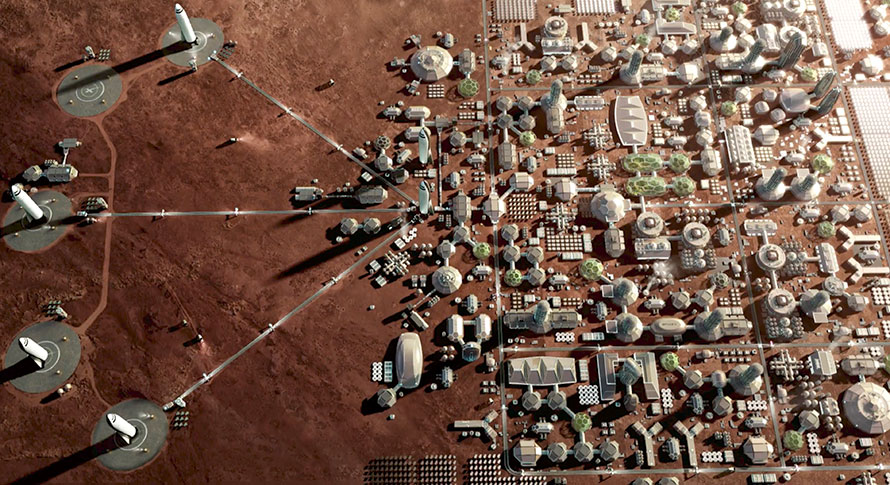 Land grants could speed up the settlement of Mars or other locations. Image: SpaceX
Land grants could speed up the settlement of Mars or other locations. Image: SpaceX
DESCRIPTION
Market economics provide an incentive for space settlements. Other economic incentives such as land grants or prizes can also be created.
Claims of title to off-Earth land could be recognized on the basis of beneficial occupancy and development. Most likely such claims would also require that the occupancy be intended to be permanent. Claims could plausibly be broadened to include additional tracts large enough to make feasible subdivision and resale. Such extraterrestrial “land grants,” akin to those granted as incentives to railroads by the U.S. after the Civil War, appear to be a likely way to foster privately funded space settlements. Such measures would increase the potential for private investment in affordable space transportation and facilities and could be the difference in making settlement economically feasible. To that end, governments and the space community will be likely to develop acceptable legal mechanisms and methods of offering such land grants as an incentive for developing permanent off-Earth settlements.
Prizes similar to the Google Lunar X-Prize could be established to challenge and inspire engineers, entrepreneurs, and innovators from around the world to develop low cost methods for constructing space settlements, life support systems, or using in-situ resources.
BARRIERS
- Existing space treaties do not allow ownership of celestial bodies by individual countries.
- Shortage of existing prizes to encourage development of technologies for permanently living away from Earth.
COMPLETION
This milestone can be considered achieved when a land grant or other economic incentive has been offered and a space facility has been built that meets the conditions of the land grant or other economic incentive.
MILESTONE 9. Technology for Adequate Self-Sufficiency
People leaving Earth with the technology and tools needed to settle, survive and prosper without needing constant resupply of survival essentials from Earth.
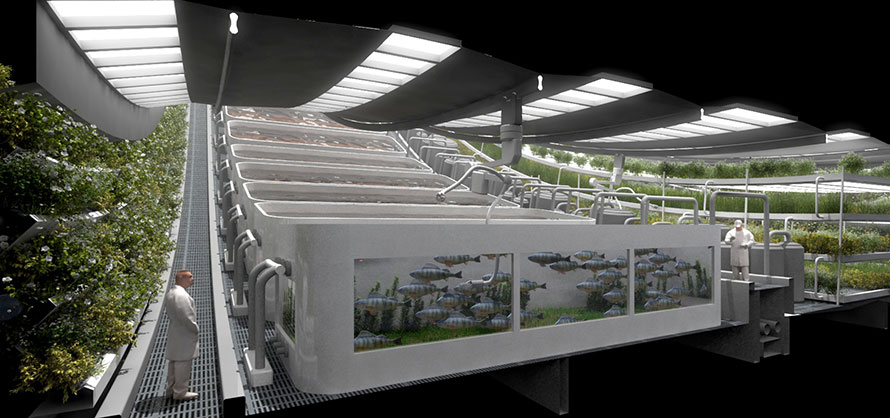 Cross-section of a 56-meter radius rotating aquaculture/hydroponics area. Image: Bryan Versteeg, spacehabs.com
Cross-section of a 56-meter radius rotating aquaculture/hydroponics area. Image: Bryan Versteeg, spacehabs.com
DESCRIPTION
For a community off Earth to thrive, it cannot be dependent upon a constant resupply from Earth of critical resources. Adequate self-sufficiency will be achieved by the development of technologies and techniques to enable the settlers to
(a) meet their basic needs for survival essentials such as air, water, power, shelter, basic foodstuffs, and the like by using local materials – e.g., soil, metals, ice and other volatiles, sunlight, and, in the case of Mars, atmosphere– such methods collectively often referred to as “in situ resource utilization” or “ISRU,” and
(b) maintain, repair, reuse, recycle and to some extent replicate the materials and tools that constitute the daily-living amenities that are the hallmarks of modern life, such as medicines, electronics and clothing.
In building towards that goal, off-Earth settlements will initially receive regular infusions of initial infrastructures and supplies (e.g., habitats, power generating equipment, medicines, tools and electronics) until a critical mass has been assembled. That initial assemblage will enable the community to achieve adequate self-sufficiency, with a need for only occasional imports of items for which the community has not yet been able to develop its own manufacturing base. At that stage regular two-way commerce, of both people and materials, will develop between the community and Earth and other off-Earth settlements. Such a development is often characterized as the essence of a “spacefaring civilization.”
As a community matures, it may achieve a level of self-sufficiency which could, if necessary, allow it to survive indefinitely without any further imports from Earth. It would be difficult for any community to become perfectly self-sufficient, as most communities on Earth are not, but trade of commodities between individual settlements in space may replace most of the importing from Earth. The importance of the degree of self-sufficiency for each type of physical supply depends highly on the required mass of the material needed per person per year or per industry per year.
COMPONENTS (required capacities, processes and steps)
Precursor Missions. Robotic precursor and test missions (followed by crewed missions) to do the following:
- Test a wide variety of synthetic materials for durability, toxicity, outgassing characteristics, etc, leaving them exposed to the off-Earth environment for long periods of time
- Land or rendezvous and verify the existence of raw materials at mining sites.
- Characterize the environment of possible settlement and mining sites.
Enabling Technologies. Substantial investments in a broad spectrum of enabling technologies and techniques:
- Methods and equipment for digging and drilling to expose and retrieve various raw materials (materials acquisition).
- Methods and equipment for converting rock, soil and volatile materials into pure volatiles for life support and propellants and into structural elements, in all locations, both on planetary surfaces and in space (in microgravity). This includes:
- Using local soil and solid minerals, combined with some volatiles, to create useful materials, e.g., metals, plastics and polymers, composites, ceramics, fabrics, soils).
- Methods to convert the materials into useful structural elements.
- Mechanisms to convert ice or atmospheric gases (volatiles) to potable and pure water, oxygen, plant growth media, rocket fuel, etc.
- Other relevant technologies including: manufacturing, miniaturization, nanotechnology, robotics, materials fabrication, energy use, structural design (e.g. hard shell habitats vs. inflatables), etc.
- Transportation systems for operations on planetary surfaces and in space between orbiting settlements and other locations.
- Materials for and methods of effective radiation shielding.
- Methods of dealing with the effects of lunar and Martian dust and electrostatics on equipment.
- Various power and energy sources (e.g., solar, nuclear, other), and energy storage systems.
- Communication techniques (both local and to Earth or other locations).
- Manufacturing processes in vacuum and near-vacuum.
- Manufacturing processes in microgravity and low-gravity conditions.
- Methods of agriculture and food production in microgravity and low-gravity conditions.
- Bioengineering and in-space food production.
- Recycling of air and organic materials (sometimes referred to as Controlled or Closed Ecological Life Support Systems, or “CELSS”).
Pilot Scale Operations. Pilot scale operations could prove out the processes that will be used at full scale, as described in the list of enabling technologies, before the full scale equipment is built and moved to where it will be used.
Full Scale Operations. Full scale operations would be used to actually build, maintain and operate the settlements, including any local industries.
The “ultimate” goal is to develop the full set of technologies needed to be able to turn “dead” asteroidal or surface rocks and minerals into “living,” maintainable, sustainable and adequately self-sufficient space habitats – almost anywhere.
These operations will become increasingly complex, as initially promising technologies and techniques (such as additive manufacturing) are tested on ever larger scales.
COMPLETION
This milestone will be considered achieved when a space settlement can exist with an amount of goods exchanged comparable to any city in a technically advanced country.
MILESTONE 10. Demonstration of Multi-Generational Human Survival off the Earth
Human reproduction and raising of children to adulthood over several generations in space
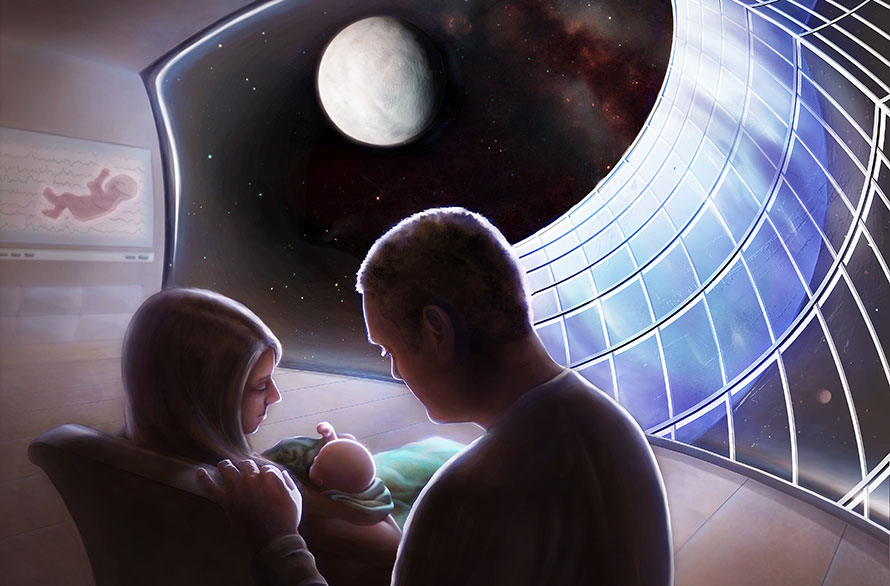
Image: Adrianna Allen, photonillustration.com
DESCRIPTION
Factors which could affect human reproduction may be different from those needed merely for survival. We know adult humans can survive periods of both lunar and micro gravity, reduced air pressure and oxygen levels, and some varying rotation rates (for artificial gravity generation in orbit), and background radiation rates. The limits for viable multi-generation human survival may differ, and should be investigated in other mammals and primates before committing to a major settlement in any proposed location. Other environmental factors may also need to be considered.
Demonstration of normal development of the mammalian life cycle is a high priority before humans attempt to raise children in large numbers in a given off-Earth location, to prove that there would be no significant or severe developmental abnormalities which could prevent normal operation and growth of a human settlement in that location. There are multiple conditions including gravity levels that could possibly cause developmental and health problems. Some of these conditions, such as gravity levels and radiation environments, are impossible or difficult to reproduce on Earth.
Even if a rotating space settlement has a 1 G artificial gravity field at the rim, there is still some possibility of developmental abnormalities (from the varying gravity levels toward the hub, the rotation itself, or the chemical and radiation environmental differences), that needs to be resolved to protect future children’s health and also the public relations aspects of space settlement itself. This means that the full range of conditions need to be tested when they vary from those on Earth. This applies to conditions on a terraformed planet as well as on a rotating space settlement.
The completion of the milestone for a single location does not necessarily remove a need for other locations which have different conditions to go through the same test sequence. Once normal development has been demonstrated at a given low gravity level and/or rotation rate, given the other assumptions of conditions as defined below, it can be assumed that development will also be normal at higher gravity levels up to 1 G and also with slower rotation rates at settlements with artificial gravity.
COMPONENTS
Verification of mammalian conception, gestation, live birth, and growth to adulthood for at least three generations at any proposed settlement site, first with rodents such as mice or rats, followed by small primates such as marmosets. The settlement site could be occupied by humans during the animal tests, but ideally no children would be conceived there until the animal tests are complete and successful. These tests would be followed by the conception, birth, and raising to adulthood of a limited number of children in the settlement environment.
Below is a list of conditions (and possible limits on them) that could possibly cause human developmental abnormalities or health problems and which need further investigation before humans settle in various locations.
- Gravity levels above or below Earth’s 1G could pose a developmental problem. Gravity levels on planets and moons cannot be controlled, but people can decide not to settle on objects where the gravity is below or above a level determined to be safe for human development. Given that the set of other conditions known to be safe on Earth is maintained, the gravity level issue itself is then primarily related (within our solar system) to settlements on worlds with low gravity levels, such as on the Moon or Mars.
- Artificial gravity on orbiting space settlements would be created by rotation. Past experiments with adult humans suggest that settlement rotation rates should be limited to no more than 2-4 rpm, although it has not been possible to test rates with a large rotational radius. Larger radii allow lower rotation rates at the same gravity level. Future tests in space will determine the appropriate rates and radii of rotation.
- Cosmic, solar and background radiation levels within a settlement habitat should be held to no more than those existing on Earth where somewhat higher than average natural levels are shown to cause little or no increase in developmental or health problems.
- Air pressure should be maintained by a majority component of nitrogen at a level sufficient to prevent an increased danger of flammability. As oxygen levels increase compared to nitrogen levels, the danger of flammability increases, except at air pressures too low to sustain life.
- Oxygen (partial pressure) levels might be somewhat less than those experienced by people living in the large high-altitude city of Quito, Ecuador. People give birth and grow to adulthood at even higher altitudes, but the small populations there could hide uncommon medical problems. Some human populations have adapted over thousands of years to living at extreme altitudes. However, many individuals have problems with altitude sickness at even lower elevations.
BARRIERS
- Lack of facilities to test plants and animals (especially mammals) in artificial gravity at different levels off Earth.
- Assumed difficulty of providing sufficient radiation shielding for rotating space settlements.
- Potential difficulty in testing the effects of the settlement location’s chemical environment (eg. outgassing, lunar dust, Mars perchlorates, etc.).
COMPLETION
This milestone can be considered achieved for a particular settlement site and design when the first third-generation human being there is conceived (of parents both conceived at the same settlement), and born and raised to biological maturity with normal health.
MILESTONE 11. An Effective Asteroid Defense System
A system capable of detecting and defending against Earth-approaching asteroids or comets built and standing by for a deflection mission on short notice.
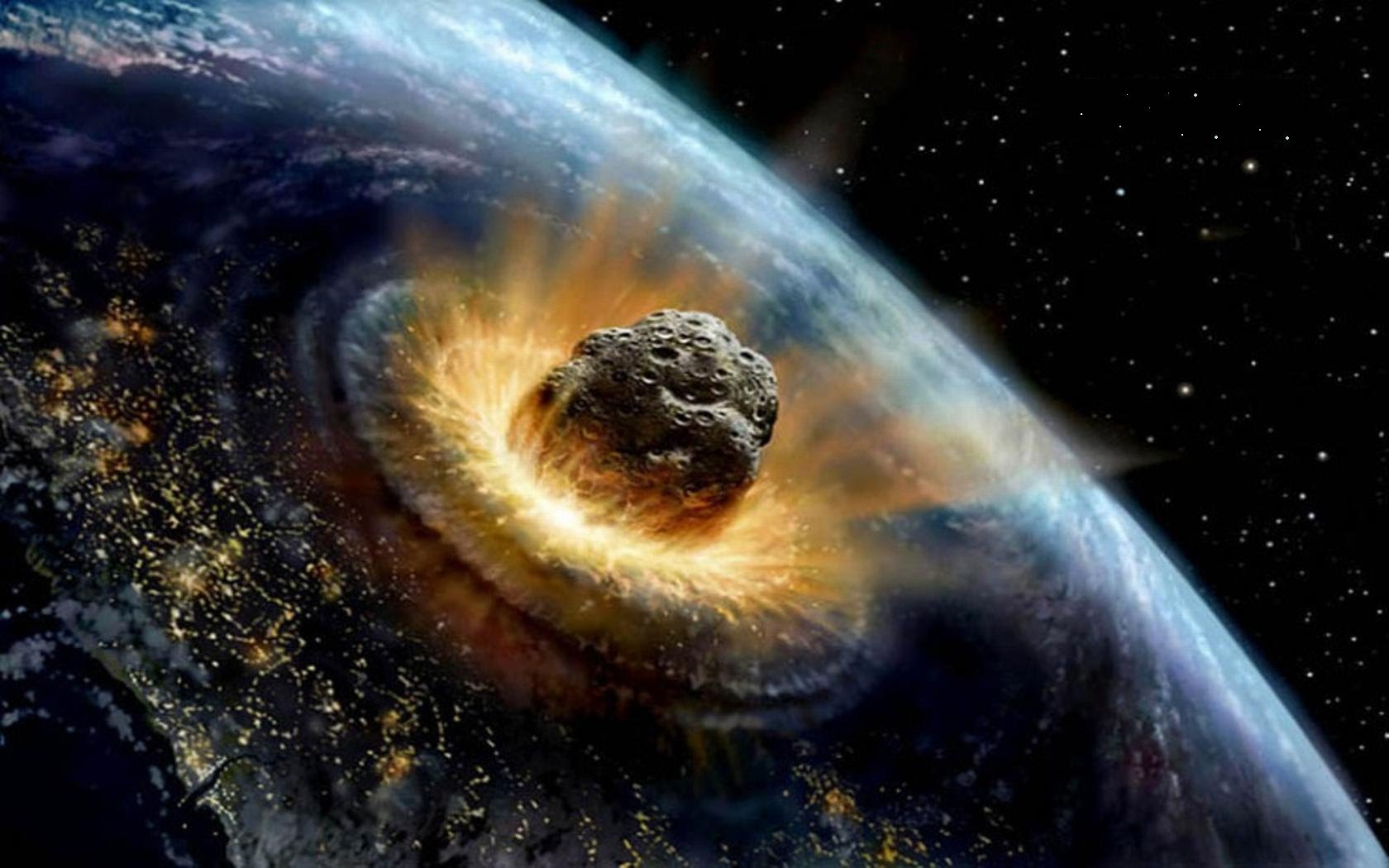 Image: David A. Hardy, www.astroart.org
Image: David A. Hardy, www.astroart.org
DESCRIPTION
It is widely recognized that the extinction of the dinosaurs was largely a result of an asteroid smashing into the Earth. That such impacts can still occur was demonstrated by the cataclysmic impacts of Comet Shoemaker-Levy 9 fragments on Jupiter in 1994 which were witnessed by hundreds of millions around the world. The 1908 Tunguska event and the 2013 near-miss airburst over Chelyabinsk are potent reminders. Hits by similar “city killer” sized asteroids are much more frequent than catastrophic climate-changing impacts. Dinosaurs could do nothing to protect themselves; humans can.
In time, just as their citizens buy home fire insurance that almost never will be used, governments will come together to create the capability to better detect threatened collisions and then design and build a defense against them.
Telescope sky scans have located and calculated the orbits of thousands of asteroids and comets, but so far have not identified any likely to be large enough or close enough to cause widespread devastation. However, large parts of the sky, especially outside the ecliptic, remain unsearched and our telescopes are still not sensitive enough to identify smaller but still dangerous objects. Every year large objects pass Earth just inside or outside the orbit of the Moon without being discovered until very close or even until after they passed. Some large comets come into the inner solar system from the Oort Cloud and would be much more difficult to detect in time to deflect.
The scientific know-how exists to divert smaller asteroids still far away from Earth. However, adequate knowledge of the composition and internal structure of the larger objects is still lacking since we need to be able to detect which asteroids are solid and which are “rubble piles.” Since different deflection and destruction methods work best on different asteroid compositions and densities, we need that knowledge to choose the best method for each asteroid. Future missions to asteroids and comets should help fill in that knowledge gap. With that information, whatever launch systems, in-space infrastructures, and deflection or removal systems are necessary to protect the Earth can and should be built, and should remain on standby for a deflection mission on short notice against a threatening celestial object that is late in being discovered. The emphasis would likely be on early detection and propulsive diversion, but higher energy or explosive methods have not been ruled out. Asteroid threats need to be dealt with on a case by case basis.
As the price of launches and other space activities comes down, asteroid defense will become more feasible and attractive to governments, and therefore likely to be achieved sooner. Since the Chelyabinsk event, the media are taking the asteroid risk more seriously, while NASA, FEMA and some international agencies are starting to take responsibility for asteroid detection, deflection, and disaster planning. Some deflection methods may not be deemed acceptable because they could be used as weapons.
COMPONENTS
- Optical and infrared telescopic asteroid detection system. Note that infrared telescopes must be located in space, and in some cases inside the orbit of Venus looking away from the sun.
- Methods of characterizing asteroids (see Milestone 26) sufficient to design an adequate defense system.
- Interplanetary mission system capable of sending an interceptor that can deflect an asteroid far enough in advance so it does not hit the Earth.
BARRIERS
- Lack of commitment to an effective asteroid defense system.
- Lack of agreement on the most effective defense method.
- Lack of agreement on politically acceptable defense methods.
COMPLETION
This milestone can be considered to be achieved when (a) a detection system is operational that can detect all asteroids/comets down to 10 meters in diameter that will approach the Earth within 1 million miles in time to defend against them, and (b) a sufficiently fast reaction method is in place for reaching any threatening asteroid/comet in time for the defense system to be deployed.
MILESTONE 12. In-space Fabrication and Construction of Large Pressurized and Unpressurized Single Piece Structures
Microgravity construction methods developed to fabricate structures that are too large to be launched intact from Earth.
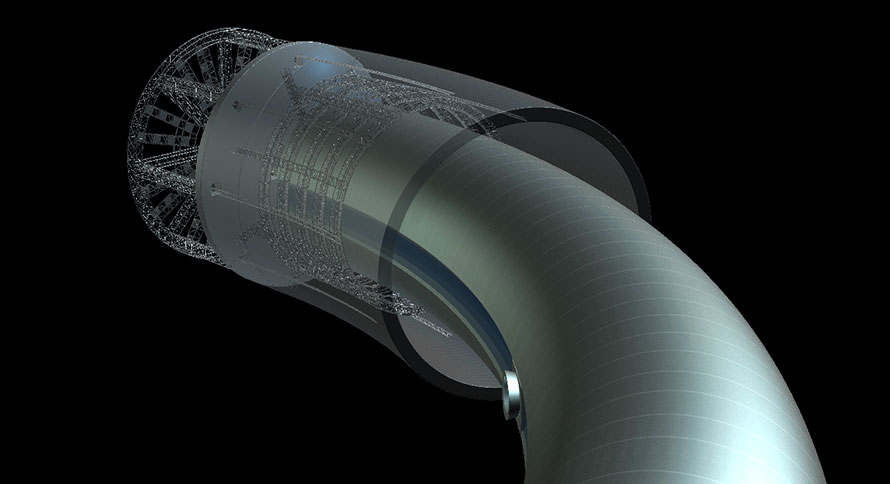
Jig factory fabricating the curving habitation tube for a Stanford Torus setlement. Image: [email protected]
DESCRIPTION
This milestone covers large space structures that are not assembled like the International Space Station, but fabricated into a single piece in space. An example of a fabrication method would be friction-stir welding. Large structures assembled from smaller components have already been built, as has been done with the space station, but the maximum size of these components limits what can be done.
Launchable pre-assembled structure diameters are limited to the diameter of the launch vehicle or those with a wider payload fairing. A larger inflatable structure could be launched if it fits the payload fairing when uninflated.
For example, a typical Stanford Torus (a large habitable space structure) could have a minor diameter of 200 meters and a major diameter of 2000 meters. This would obviously be far too large to be launched from the ground. The large in-space structure fabrication and construction ability can also be applied to fabricating the unpressurized parts of such structures, and very large unpressurized space structures such as jig factories. This capability will enable the construction of rotating space settlements, and the eventual construction of massive starships.
COMPONENTS (requirements)
- Very large robotic jig factories and/or additive manufacturing factories, etc. in orbit. A jig factory is a very large industrial jig (a framework that keeps a workpiece from moving while it is being worked on), where the entire factory is the jig.
- A large supply of construction parts made from material from asteroids or moons.
BARRIERS
- Lack of methods to mine asteroids or moons and to turn the derived materials and minerals into structural components.
- Lack of efficient in-space transport to move heavy materials to the desired sites in space.
- Lack of advanced robotic factory designs, construction methods and robotic software and equipment.
- The difficulty of operating in a vacuum, in microgravity, with a minimum of personnel.
COMPLETION
This milestone can be considered achieved when the first space manufacturing facility is built that can create one-piece structures that are too large to be launched from Earth.







